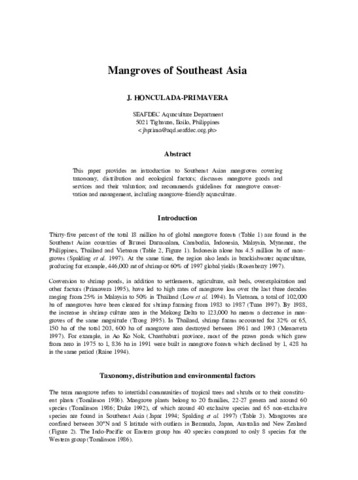Biodiversity in mangrove-derived aquaculture ponds in Dumangas, Iloilo, Philippines
Share
စိတ္တဇ
Large tracts of mangroves have been converted into aquaculture ponds and the consequent loss of biodiversity has been much decried. This paper shows that high aquatic biodiversity is retained in mangrove-derived aquaculture ponds in Dumangas, Iloilo, Philippines. Documentation of biodiversity was carried out over two years in 15 adjacent ponds (water areas 0.25–0.9 ha) used for farming penaeid shrimps, mud crabs, milkfish, seabass, rabbitfish, and other fishes. At harvest, these ponds yielded many extraneous non-crop or “bycatch” species, which had been naturally seeded by the tides and had grown (and some species reproduced) over the 2–10 mo that the ponds were underwater. From 21 crop cycles were obtained 8–56 species (from 6–30 taxonomic families) of bycatch fishes and macrocrustaceans with biomass of 2.5–168.4 kg ha–1 and abundance of 2–92 x 103 individuals ha–1, the differences due to pond area, duration of immersion, farming system, crop species, and the bycatch community. Some 85 species (44 families) of fishes occurred in the ponds, including 12 species of gobies, of which the small-size Acentrogobius viganensis, Pseudogobius javanicus, Mugilogobius cavifrons, and Gobiopterus panayensis reached high abundance. Macrocrustaceans consisted of 30 species (nine families), including several penaeid and palaemonid shrimps (Metapenaeus ensis and Nematopalaemon tenuipes were most common) and portunid and grapsid crabs. Mollusks in the ponds included 58 species (24 families), of which Cerithideopsilla cingulata was most abundant. The Dumangas ponds were leaky and allowed tidal recruitment of many mangrove animals despite net screens and chemical treatments. Existing tidal ponds serve as proxy mangrove lagoons (wetlands) that can harbor high aquatic biodiversity.
Suggested Citation
Bagarinao, T. (2021). Biodiversity in mangrove-derived aquaculture ponds in Dumangas, Iloilo, Philippines. Philippine Journal of Science , 150(1), 153-169. http://hdl.handle.net/10862/6042
ဘာသာရပ်
Taxonomic term
စုစည်းမှုများ စုစည်းမှုများ
- AQD Journal Articles [1249]
Related items
Showing items related by title, author, creator and subject.
-
Milkfish ponds from mangroves
Bagarinao, Teodora (Aquaculture Department, Southeast Asian Fisheries Development Center, 1998) -
Mangroves of Southeast Asia
Honculada-Primavera, J. (Aquaculture Department, Southeast Asian Fisheries Development Center, 2000)This paper provides an introduction to Southeast Asian mangroves covering taxonomy, distribution and ecological factors; discusses mangrove goods and services and their valuation; and recommends guidelines for mangrove ... -
The genetic garden
Southeast Asian Fisheries Development Center, Aquaculture Department (Aquaculture Department, Southeast Asian Fisheries Development Center, 1995)The article discusses some strategies in the establishment of a mangrove genetic garden where species could be maintained. The genetic garden is a sustainable way to prevent further damage of the remaining mangroves. Its ...




